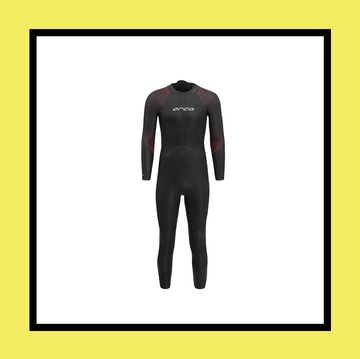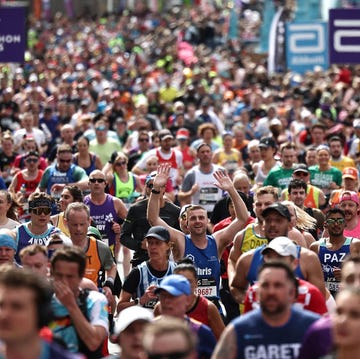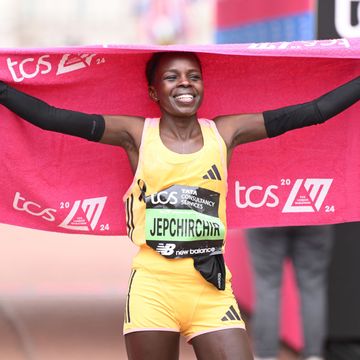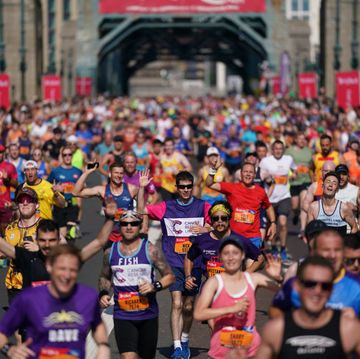The World Health Organisation defines stress as any type of change that causes physical, emotional or psychological strain. The Hungarian-Canadian endocrinologist Hans Selye developed the concept of a ‘general adaptation syndrome’, where organisms respond to stress in a similar way regardless of what causes it. Selye defined three response stages. Initially, the ‘alarm’ stage is characterised by a release of hormones (such as cortisol) and other processes that create our flight-or-fight response. The second stage of ‘resistance’ is where organisms adapt and develop resistance to the stress. And finally, ‘exhaustion’, where, if a stress is applied for long enough, organisms can no longer respond and start to break down and lose resistance. This concept is useful when applied to running because it recognises that a managed dose of acute stress can be beneficial, but a heavy or sustained dose of chronic stress can become negative. As runners, we must focus on our dosage.
The stress balance
Our fitness relies on a balance between the stimulus from stress and the adaptation from recovery. When our managed doses of acute stress balance with recovery, our body goes through a process known as super compensation, adapting and building resistance. But when stress outweighs our ability to recover – especially for prolonged periods – our body goes through a catabolic process of breaking down.
If we get to this point, we risk injury and poor performance, as well as losing the ability to build further fitness. We’re also likely to see changes such as a loss of enjoyment, poor sleep and even wider physical changes that affect long-term health.
Different types of stress
To get this balance right, we need to consider stress in the broadest sense.
Stress from training
This is the physical stress we create through our training decisions. Through a balance of the frequency, intensity and volume, and how it builds overtime, we can create a stress stimulus to help us build fitness. This needs to be considered at a macro level– the overall training load from our training plan over a long period; a meso level – the impact of changes in stress through a training cycle, for example when building up to a specific race; and a micro level– the impact of training stress from our training week and individual sessions. These can be considered controllable variables. However, just because they’re controllable, doesn’t mean we always get these decisions right.
Stress from life
Selye’s concept of ‘general adaptation syndrome’ means we also have to look beyond the physical stress created from training and view wider stressors that might also need accounting for. It’s all too easy to ignore the impact psychological stress has on our physical health. Exam periods at university have been shown to have an impact on injury rates for athletes; the same can be said for periods of high stress at work or in your personal life. These changes can have a big impact on your balance of stress and recovery.
Measure your stress
Your body isn’t a machine and we can’t simply plug our training into a calculator and assume we know what result we’ll get. Instead, we need to develop some measures to detect whether we’re ready to adapt to the work we plan to do. There are some tools that can help with this.
Heart rate variability (HRV):
This is a measurement of the variation in time between each heartbeat, and is controlled by your autonomic nervous system (ANS). HRV can be used as a method of monitoring changes in your autonomic nervous system, so it is a method of assessing your state of stress. Generally, the greater your HRV, the better you are recovering and the more receptive you will be to further training stress. It can help tell you if your training load is balanced. As athletes, we’re often not very good at knowing when to push and when to back off, so it can be a very useful tool for becoming more adaptive in our training. It can be monitored on many running and smartwatches.
Blood tests:
While they can be expensive, blood tests, if used regularly, can provide a detailed picture of changes in a range of markers (such as cortisol, adrenaline, noradrenaline, dopamine and aldosterone) that can indicate stress levels.
Self-scored stress questionnaires:
A simple self-scored questionnaire carried out on a weekly basis can be enormously valuable. Draw up a list of areas to score yourself on a scale from zero to 10; for example, how well you felt you trained, how motivated you were to train, your levels of pain or discomfort from training, your levels of work and family life stress, the quality of your sleep, your general emotional state and your nutrition. Use this to track changes over a period of weeks. Ask your family or friends, too, as they might give a broader perspective.
Training data:
Modern GPS watches can provide a lot of data to help you assess your recovery and readiness to train by collating your training time, heart rate and intensity into training stress scores that allow you to track changes over time. In short, a detailed training diary can be an important tool to monitor your stress levels.
Manage your stress
Once you’ve developed your monitoring tools, find ways to control your stress and work out if it’s something you need to reduce or something you need to accept and adapt around.
Stay FIT
Consider the frequency, intensity and volume (time) of your training. If you change too many variables at once, you are likely to load too much on the stress side of
the equation.
Complete stressors
In addition to the FIT principles, be aware that environmental changes such as warm weather or altitude or a change in terrain will alter your stress levels.
Avoid the peaks
Before you set yourself your next big racing goal, take a look at how it fits with your life. Big work or study deadlines, stressful family dates or periods with lots of travel aren’t conducive to increased training stress. Think carefully where you place your key goal races.
Plan adaptively
Training plans are useful in providing a sense of direction, but aim for an adaptive approach, where your training responds to day-to-day and week-to-week changes in life stress.
Create space
Ensure you allow enough low-intensity training between your hard workouts to allow your stress to reduce. Doing too many hard runs risks throwing your stress/recovery balance out of whack.
Chronic concerns
Intense periods of training are often required when building to key races. But consistent, 80% easy training with small managed doses of stress will have more benefit in the end than rapid changes.
Manage monotony
Excessive monotony in training has been shown to increase the risks of overtraining. Mix your terrain, types of training sessions and aim to complete some of your training runs with other runners if you can.
Downtime
Planned downtime and breaks from training in your year are very useful in reducing the physical and mental stress of training. More than this, though, plan activities away from running that help to lower mental stress. Yoga, reading, walks and time with family and friends have been shown to reduce cortisol levels.
Sleep and eat
Good, consistent sleep and a balanced healthy approach to food, ensuring you’re meeting all your macro- and micronutrient demands, will help your body speed up the recovery and adaptive processes.














